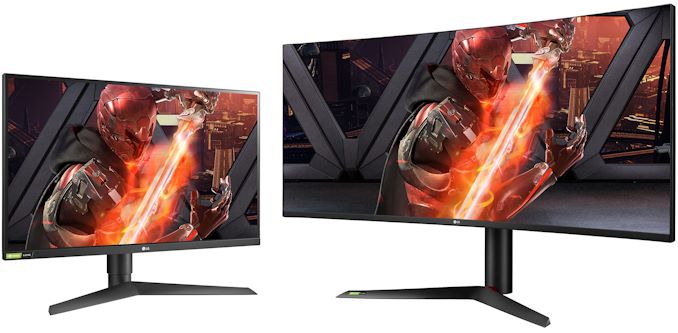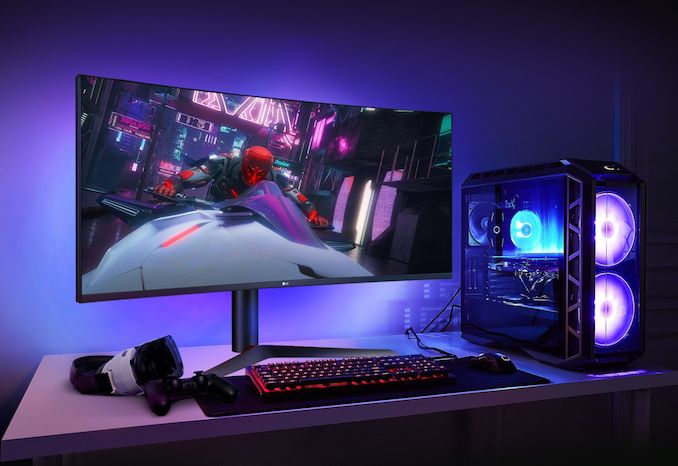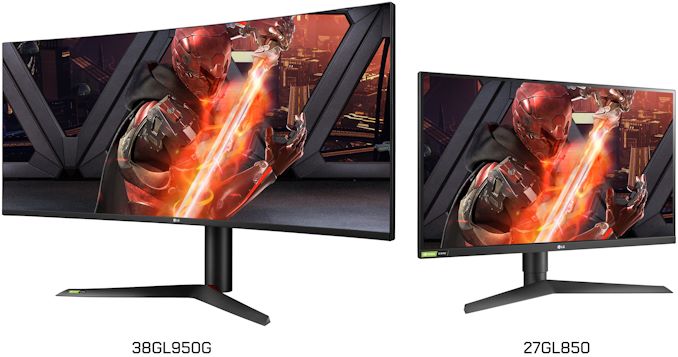LG Unveils 27 and 37.5-Inch IPS Monitors with 1 ms Response Time
by Anton Shilov on June 13, 2019 5:00 PM EST
LG has introduced the industry’s first IPS displays featuring a 1 ms response time. The new UltraGear monitors bring together high image quality that LG’s Nano IPS panels are known for, the DCI-P3 color gamut, high performance, and NVIDIA G-Sync support. Aimed primarily at gamers, the new UltraGear monitors will come in 27-inch and 37.5-inch sizes.
The smaller monitor is the LG UltraGear 27GL850 that uses a 27-inch IPS panel featuring a 2560×1440 (16:9) resolution, 350 nits brightness, a 144 Hz refresh rate, and 1 ms GtG response time. The larger display is the UltraGear 38GL950G based on a 37.5-inch panel offering a wider aspect ratio 3840×1600 (21.5:9) resolution, 450 nits brightness, a 175 Hz refresh rate (when overclocked), and also a 1 ms response time. The smaller monitor supports HDR10, whereas the bigger one is DisplayHDR 400 certified.
Both UltraGear 27GL850 and UltraGear 38GL950G LCDs can display 1.07 billion colors and cover 98% of the DCI-P3 color gamut, a very good result for gaming-grade monitors. The two displays also feature LG’s Nano IPS panels featuring a special nanoparticle cover applied to the screen’s LED backlighting to fine-tune its spectral output to absorb surplus light wavelengths and increase intensity, purity, as well as the accuracy of the on-screen colors.
Since LG’s UltraGear displays are designed primarily for gamers, both support a number of features aimed at this audience. Apart from NVIDIA’s G-Sync dynamic refresh rate technology, the new LCDs also support LG’s Dynamic Action Sync mode, Black Stabilizer, and Crosshair functions. Besides, the larger display supports LG’s Sphere Lighting 2.0 technology.
As far as connectivity is concerned, both LG’s UltraGear 27GL850 and UltraGear 38GL950G monitors feature DisplayPort and HDMI inputs, as well as a dual-port USB 3.0 hub. Meanwhile, they have neither a headphone jack nor integrated speakers.
| The LG UltraGear-Series Displays | |||
| 27GL850 | 38GL950G | ||
| Panel | 27" IPS | 37.5" IPS | |
| Native Resolution | 2560 × 1440 (16:9) |
3840 × 1600 (21.5:9) |
|
| Refresh Rate | 144 Hz | Native: ? Hz Overclocked: 175 Hz |
|
| Dynamic Refresh Rate | Technology | NVIDIA G-Sync compatible | NVIDIA G-Sync |
| Range | ? | ? | |
| Response Time | 1 ms (gray-to-gray) | ||
| Brightness | 350 cd/m² | 450 cd/m² | |
| Contrast | ? | ||
| Color Gamut | 125% sRGB 98% DCI-P3 |
||
| Viewing Angles | 178°/178° horizontal/vertical (?) | ||
| Curvature | none | curved | |
| Inputs | 1 × DisplayPort 1.2 2 × HDMI 2.0 |
1 × DisplayPort 1.2 1 × HDMI 2.0 |
|
| USB Hub | 2 × USB 3.0 Type-A | 2 × USB 3.0 Type-A | |
| Audio | none | ||
| Proprietary Enhancements | Dynamic Action Sync mode, Black Stabilizer, Crosshair |
||
| Stand | Height | ? | |
| Tilt | ? | ? | |
| Swivel | ? | ? | |
| Power Consumption | Idle | ? | |
| Typical | ? | ||
| Maximum | ? | ||
LG plans to start sales of the UltraGear 27GL850 display in the third quarter with pre-orders in the US starting on July 1, 2019. LG does not disclose pricing of either UltraGear 27GL850 or UltraGear 38GL950G monitors, but without any doubts both will belong to the company’s premium family of products.
Related Reading:
- LG Unveils UltraGear 34GK950 34-Inch Curved Gaming Displays with Nano-IPS
- LG to Demo UltraWide 38-Inch 144Hz Gaming & 49-Inch Workstation Displays at CES
- LG Launches Midrange 32UL750-W Monitor: DisplayHDR 600 with FreeSync & USB-C For $750
Source: LG












49 Comments
View All Comments
imaheadcase - Friday, June 14, 2019 - link
To further that, they announced them..THREE times. They was only "6 months" away each time.Diji1 - Friday, June 14, 2019 - link
>Besides not many people care about HDR at all, it really is just a silly thingIt's a large increase in image quality so clueless people don't care about it I guess.
Skeptical123 - Tuesday, June 18, 2019 - link
"Real HDR" requires 1000 nits, for this product segment that does not make since. Both of these monitors will already be at the top of the pack. I don't see why LG would increase the cost and size so much to get a feature games the target market don't care for (and if they do this is still one of the best options regardless). Also HDMI 2.1 validation has not been out long enough to get these monitors shipped. It would be dumb for lg to wait around to launch a flag ship product because it does not support the highest number HDMI spec. Also UHD/4k kick stop shit posting it's more complicated than the number on the box. Related to monitor price, cable limitations, cpu cost, application utilization ect.mdrejhon - Friday, June 14, 2019 - link
It's important for manufacturers advertise both GtG and MPRT -- two different pixel response benchmarks.https://www.blurbusters.com/gtg-vs-mprt
futrtrubl - Friday, June 14, 2019 - link
"feature LG’s Nano IPS panels featuring a special nanoparticle cover applied to the screen’s LED backlighting to fine-tune its spectral output to absorb surplus light wavelengths and increase intensity, purity, as well as the accuracy of the on-screen colors." So quantum dots.Krysto - Friday, June 14, 2019 - link
Okay, it seems everyone is reaching close to 100% P3 lately. When are we going to start demanding support for Rec. 2020/2100?MisterAnon - Friday, June 14, 2019 - link
Resolution way too small for the size of these things. Will give you horrible pixel density.Skeptical123 - Tuesday, June 18, 2019 - link
What do you mean? To hi too low. 27inch 2k is consider the "sweet spot" for most people. As most people can use windows without scaling and you can't see the pixels unless you pixel peep. For the wide screen I'm not as sure on.Beaver M. - Friday, June 14, 2019 - link
They seriously removed GSync from the 27GL850...I waited for this monitor so long and now this...
IDK wtf is wrong with monitor/panel manufacturers, but they obviously think their customers are stupid.
mode_13h - Saturday, June 15, 2019 - link
$$$?How much better is full GSync than good GSync-compat?